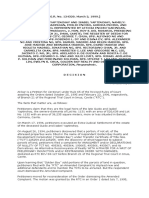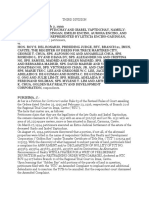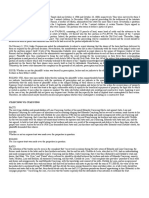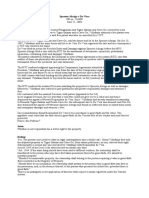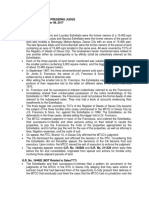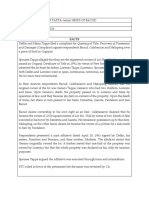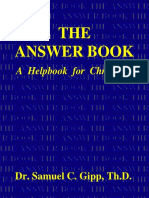CaseDigests Set4
CaseDigests Set4
Uploaded by
Jamila UrbinaCopyright:
Available Formats
CaseDigests Set4
CaseDigests Set4
Uploaded by
Jamila UrbinaOriginal Description:
Original Title
Copyright
Available Formats
Share this document
Did you find this document useful?
Is this content inappropriate?
Copyright:
Available Formats
CaseDigests Set4
CaseDigests Set4
Uploaded by
Jamila UrbinaCopyright:
Available Formats
JOHNNY S. RABADILLA vs. COURT OF APPEALS AND MARIA MARLENA COSCOLLUELA Y BELLEZA VILLACARLOS FACTS: Dr.
Jorge Rabadilla, in a codicil of Aleja Belleza, was instituted devisee of Lot No. 1392 with an area of 511,855 square meters with the obligation to deliver 100 piculs of sugar to herein private respondent every year during the latter's lifetime. The codicil provides that the obligation is imposed not only on the instituted heir but also to his successors-ininterest and that in case of failure to deliver, private respondent shall seize the property and turn it over to the testatrix's "near descendants." Dr. Rabadilla died and was survived by his wife and children, one of whom is herein petitioner. Private respondent, alleging failure of the heirs to comply with their obligation, filed a complaint with the RTC praying for the reconveyance of the subject property to the surviving heirs of the testatrix. During the pre-trial, a compromise agreement was concluded between the parties wherein the lessee of the property assumed the delivery of 100 piculs of sugar to private respondent. However, only partial delivery was made. Thereafter, the trial court dismissed the complaint for lack of cause of action. The Court of Appeals, on appeal, reversed the decision and held that the institution of Dr. Rabadilla is in the nature of a modal institution and a cause of action in favor of private respondent arose when petitioner failed to comply with their obligation under the codicil, and in ordering the reversion of Lot 1392 to the estate of testatrix. Aggrieved, petitioner availed of this recourse. ISSUE: WoN there was fideicommisary substitution as contended by respondents. RULING: In the case, the provisions of subject Codicil do not provide that should Dr. Jorge Rabadilla default due to predecease, incapacity or renunciation, the testatrix's near descendants would substitute him. What the Codicil provides is that, should Dr. Jorge Rabadilla or his heirs not fulfill the conditions imposed in the Codicil, the property referred to shall be seized and turned over the testatrix's near descendants. Neither is there a fideicommissary substitution. In the case under consideration, the instituted heir is in fact allowed under the Codicil to alienate the property provided the negotiation is with the near descendants or the sister of the testatrix. Thus, a very important element of a fideicommissary substitution is lacking; the obligation clearly imposing upon the first heir the preservation of the property and its transmission to the second heir. "Without this obligation to preserve clearly imposed by the testator in his will, there is no fideicommissary substitution." Also, the near descendants' right to inherit from the testatrix is not definite. The property will only pass to them should Dr. Jorge Rabadilla or his heirs not fulfill the obligation to deliver part of the usufruct to private respondent. Another important element of a fideicommissary substitution is also missing here. Under Article 863, the second heir or the fideicommissary to whom the property is transmitted must not be beyond one degree from the first heir or the fiduciary. A fideicommissary substitution is therefore, void if the first heir is not related by first degree to the second heir. In the case under scrutiny, the near descendants are not at all related to the instituted heir, Dr. Jorge Rabadilla. TERESITA P. BORDALBA vs. COURT OF APPEALS, HEIRS OF NICANOR JAYME, namely, CANDIDA FLORES, EMANNUEL JAYME, DINA JAYME DEJORAS, EVELIA JAYME, and GESILA JAYME; AND HEIRS OF ASUNCION JAYMEBACLAY, namely, ANGELO JAYME-BACLAY, CARMEN JAYME-DACLAN and ELNORA JAYME BACLAY FACTS: The instant controversy stemmed from Lot No. 1242 (Lot No. 799-C) with an area of 1,853 square meters and located at Barrio Looc, Mandaue City, originally owned by the late spouses Carmeno Jayme and Margarita Espina de Jayme. In 1947, an extra-judicial partition was made and equally disposing, inter alia, the same parcel of land to: (1) Nicanor and Asuncion Jayme-Baclay, their grandchildren and their heirs (private respondents); (2) Elena, their daughter (mother of petitioner); and (3) an unidentified party. In 1964, their daughter, Elena, filed with RTC Cebu an amended application for the registration of the lot. Nicanor Jayme and Asuncion Jayme-Baclay filed their opposition contending that said application included the 1/3 portion inherited by them in the 1947 extra-judicial partition. RTC DISMISSED for lack of interest of the parties. Subsequently, petitioner filed with the Bureau of Lands of Cebu City an application seeking the issuance of a Free Patent over the same lot subject of the aborted application of her mother, Elena Jayme, now known as Lot No. 1242 (799-C). In April 1980, petitioner was successfully granted a Free Patent over said lot, Thereafter, petitioner caused the subdivision and titling of Lot No. 1242 (799-C), into 6 lots, as well as the disposition of two parcels thereof. Private respondents thus filed with the RTC Mandaue City the instant complaint against petitioner Teresita Bordalba, spouses Genaro U. Cabahug, and Rita Capala, Rural Bank of Mandaue and the Director of the Bureau of Lands, praying that the free patent no., OCT no. and the TCT nos. be declared void and ordered cancelled. Also, they prayed that they be adjudged owners of Lot No. 1242 (799-C), and that spouses Genaro V. Cabahug and Rita Capala as well as the Rural Bank of Mandaue be declared buyers
and mortgagee in bad faith, respectively. Petitioner claimed that Nicanor Jayme, and Candida Flores occupied a portion of Lot No. 1242 (799-C) by mere tolerance of her mother. RTC, finding that fraud was employed by petitioner in obtaining Free Patent No. (VII-I) 11421 and OCT No. 0-571 (FP), declared said patent and title void and ordered its cancellation. However, it declared that spouses Genaro U. Cabahug and Rita Capala as well as the Rural Bank of Mandaue are purchasers and mortgagee in good faith, respectively. CA affirmed with modification the decision of the RTC on appeal, ruling that private respondents are entitled only to 1/3 portion of Lot No. 1242 (799-C), petitioner should be ordered to reconvey 1/3 of Lot No. 1242 (799-C) to private respondents. ISSUE: WoN the Court of Appeals correctly pointed out that misrepresentation tainted petitioner's application, insofar as her declaration that the land applied for was not occupied or claimed by any other person. RULING: The Court sees no reason to deviate from the findings of the trial court that petitioner resorted to fraud and misrepresentation in obtaining a free patent and title over the lot under scrutiny. The Court of Appeals correctly pointed out that misrepresentation tainted petitioner's application, insofar as her declaration that the land applied for was not occupied or claimed by any other person. Her declaration is belied by the extra-judicial partition which she acknowledged, her mother's aborted attempt to have the lot registered, private respondents' predecessors-in-interest's opposition thereto, and by the occupancy of a portion of the said lot by Nicanor Jayme and his family since 1945. Likewise untenable is the claim of petitioner that private respondents are not legal heirs of Nicanor Jayme and Asuncion Jayme-Baclay. Other than their bare allegations to dispute their heirship, no hard evidence was presented by them to substantiate their allegations. Besides, in order that an heir may assert his right to the property of a deceased, no previous judicial declaration of heirship is necessary. HEIRS OF IGNACIO CONTI and ROSARIO CUARIO vs. COURT OF APPEALS and LYDIA S. REYES as Attorney-in-Fact of JOSEFINA S. REYES, BERNARDITA S. PALILIO, HERMINIA S. PALILIO, REMEDIOS A. SAMPAYO, ILUMINADA A. SAMPAYO, ENRICO A. SAMPAYO, CARLOS A. SAMPAYO, GENEROSO C. SAMPAYO, MYRNA C. SAMPAYO, ROSALINO C. SAMPAYO, MANUEL C. SAMPAYO, DELIA A. SAMPAYO, CORAZON C. SAMPAYO, NILO C. SAMPAYO, and LOLITA A. SAMPAYO in her own behalf and as Attorney-in-Fact of NORMA A. SAMPAYO FACTS: Lourdes Sampayo and Ignacio Conti, married to Rosario Cuario, were the co-owners of the property in litigation, at the corner of Zamora and Abellanosa Streets, Lucena City, with a house erected thereon. On 17 March 1986 Lourdes Sampayo died intestate without issue. Subsequently, on 1 April 1987 private respondents, all claiming to be collateral relatives of the deceased Lourdes Sampayo, filed an action for partition and damages before RTC Lucena. The spouses Ignacio Conti and Rosario Cuario refused the partition on the ground that private respondents failed to produce any document to prove that they were the rightful heirs of Lourdes Sampayo. At the trial, private respondents presented Lydia Sampayo Reyes and Adelaida Sampayo to prove that they were the collateral heirs of the deceased Lourdes Sampayo and therefore entitled to her rights as co-owner of the subject lot, by bringing with her certificates of live birth and certificates of baptism. To rebut whatever rights the alleged heirs of Lourdes had over the subject lot, petitioners presented Rosario Cuario Conti, Rosa Ladines Malundas and Rodolfo Espineli. Rosario testified that the subject property was co-owned in equal shares by her husband Ignacio Conti and Lourdes Sampayo and that her family (Rosario) had been staying in the subject property since 1937. However, as correctly found by the trial court, no will, either testamentary or holographic, was presented by petitioners to substantiate this claim. In April 1991, RTC declared private respondents as the rightful heirs of Lourdes Sampayo. It further ordered private respondents and petitioners to submit a project of partition of the residential house and lot for confirmation by the court. Petitioners elevated the case to the Court of Appeals contending that the trial court erred in finding that private respondents were the heirs of Lourdes Sampayo and that they were entitled to the partition of the lot and the improvements thereon. CA affirmed the RTC decision, holding that respondents proved by preponderance of evidence
that they are the collateral heirs of deceased Lourdes Sampayo, and that a prior and separate judicial declaration of heirship was NOT necessary, automatically becoming co-owners upon her death. ISSUE: WoN petitioners were correct in arguing that a complaint for petition to claim a supposed share of the deceased co-owner cannot prosper without prior settlement of the latter's estate and compliance with all legal requirements, especially publication, and since private respondents were not able to prove by competent evidence their relationship with the deceased. RULING: There is no merit in the petition. A prior settlement of the estate is not essential before the heirs can commence any action originally pertaining to the deceased. Conformably with the foregoing and taken in conjunction with Arts. 777 and 494 of the Civil Code, from the death of Lourdes Sampayo her rights as a co-owner, incidental to which is the right to ask for partition at any time or to terminate the co-ownership, were transmitted to her rightful heirs. In so demanding partition private respondents merely exercised the right originally pertaining to the decedent, their predecessor-in-interest. Succession is a mode of acquisition by virtue of which the property, rights and obligations to the extent of the value of the inheritance of a person are transmitted through his death to another or others either by his will or by operation of law. Legal or intestate succession takes place if a person dies without a will, or with a void will, or one which has subsequently lost its validity. If there are no descendants, ascendants, illegitimate children, or a surviving spouse, the collateral relatives shall succeed to the entire estate of the decedent. It was established during the trial that Lourdes died intestate and without issue. Private respondents as sister, nephews and nieces now claim to be the collateral relatives of Lourdes. Under Art. 172 of the Family Code, the filiation of legitimate children shall be proved by any other means allowed by the Rules of Court and special laws, in the absence of a record of birth or a parent's admission of such legitimate filiation in a public or private document duly signed by the parent. Such other proof of one's filiation may be a baptismal certificate, a judicial admission, a family Bible in which his name has been entered, common reputation respecting his pedigree, admission by silence, the testimonies of witnesses and other kinds of proof admissible under Rule 130 of the Rules of Court. By analogy, this method of proving filiation may also be utilized in the instant case. ALICIA E. GALA, GUIA G. DOMINGO and RITA G. BENSON vs. ELLICE AGRO-INDUSTRIAL CORPORATION, MARGO MANAGEMENT AND DEVELOPMENT CORPORATION, RAUL E. GALA, VITALIANO N. AGUIRRE II, ADNAN V. ALONTO, ELIAS N. CRESENCIO, MOISES S. MANIEGO, RODOLFO B. REYNO, RENATO S. GONZALES, VICENTE C. NOLAN, NESTOR N. BATICULON FACTS: Manuel and Alicia Gala, their children and their encargados formed and organized the Ellice Agro-Industrial Corporation (Ellice). The Gala spouses transferred several parcels of land to Ellice as payment for their subscriptions. Subsequently, the Margo Management and Development Corporation (Margo) was incorporated. Several transfers of shares were made by the shareholders from Ellice to Margo. Respondents then filed a petition against petitioners with the Securities and Exchange Commission (SEC) alleging mismanagement, diversion of funds, financial losses and dissipation of assets. In turn, petitioners initiated a complaint against respondents, praying for, among others, the return of all titles to real property in the name of Margo and Ellice. The SEC rendered a joint decision in the consolidated cases dismissing the petition filed by respondents and ruling against the respondents with respect to the petition filed by petitioners. However, the joint decision was reversed by the SEC En Banc on appeal by respondents. Petitioners filed a petition for review with the Court of Appeals which affirmed the decision of the SEC En Banc. Hence, this petition, where petitioners argued that the separate juridical personalities of Ellice and Margo should be disregarded for the purpose of treating all property purportedly owned by said corporations as property solely owned by the Gala spouses. In denying the petition, the Supreme Court ruled that to warrant resort to the extraordinary remedy of piercing the veil of corporate fiction, there must be proof that the corporation is being used as a cloak or cover for fraud or illegality, or to work injustice, and the petitioners have failed to prove that Ellice and Margo were being used thus. They have not presented any evidence to show how the separate juridical entities of Ellice and Margo were used by the respondents to commit fraudulent, illegal or unjust acts.
DY YIENG SEANGIO, BARBARA D. SEANGIO and VIRGINIA D. SEANGIO vs. HON. AMOR A. REYES, in her capacity as Presiding Judge, Regional Trial Court, National Capital Judicial Region, Branch 21, Manila, ALFREDO D. SEANGIO, ALBERTO D. SEANGIO, ELISA D. SEANGIO-SANTOS, VICTOR D. SEANGIO, ALFONSO D. SEANGIO, SHIRLEY D. SEANGIO-LIM, BETTY D. SEANGIO-OBAS and JAMES D. SEANGIO FACTS: On September 21, 1988, private respondents filed a petition for the settlement of the intestate estate of the late Segundo Seangio and praying for the appointment of private respondent Elisa D. Seangio-Santos as special administrator and guardian ad litem of petitioner Dy Yieng Seangio. Petitioners Dy Yieng, Barbara and Virginia, all surnamed Seangio, opposed the petition. They contended that: 1) Dy Yieng is still very healthy and in full command of her faculties; 2) the deceased Segundo executed a general power of attorney in favor of Virginia giving her the power to manage and exercise control and supervision over his business in the Philippines; 3) Virginia is the most competent and qualified to serve as the administrator of the estate of Segundo because she is a certified public accountant; and, 4) Segundo left a holographic will, dated September 20, 1995, disinheriting one of the private respondents, Alfredo Seangio, for cause. In view of the purported holographic will, petitioners averred that in the event the decedent is found to have left a will, the intestate proceedings are to be automatically suspended and replaced by the proceedings for the probate of the will. On July 1, 1999, private respondents moved for the dismissal of the probate proceedings on the ground that the document purporting to be the holographic will of Segundo does not contain any disposition of the estate of the deceased pursuant to Article 783. According to private respondents, the will only shows an alleged act of disinheritance by the decedent of his eldest son, Alfredo, and nothing else; that all other compulsory heirs were not named nor instituted as heir, devisee or legatee, hence, there is preterition which would result to intestacy. Such being the case, private respondents maintained that while procedurally the court is called upon to rule only on the extrinsic validity of the will, it is not barred from delving into the intrinsic validity of the same, and ordering the dismissal of the petition for probate when on the face of the will it is clear that it contains no testamentary disposition of the property of the decedent. Petitioners filed their opposition to the motion to dismiss contending that: 1) generally, the authority of the probate court is limited only to a determination of the extrinsic validity of the will; 2) private respondents question the intrinsic and not the extrinsic validity of the will; 3) disinheritance constitutes a disposition of the estate of a decedent; and, 4) the rule on preterition does not apply because Segundo's will does not constitute a universal heir or heirs to the exclusion of one or more compulsory heirs. RTC DISMISSED the petition for probate, thus clearly showing that there is preterition. MR was likewise denied by RTC. ISSUES: 1. WoN there was valid disinheritance. 2. WoN preterition and disinheritance exist, thus making the will both intrinsically and extrinsically valid. RULING: 1. The purported holographic will of Segundo that was presented by petitioners was dated, signed and written by him in his own handwriting. Except on the ground of preterition, private respondents did not raise any issue as regards the authenticity of the document. The document, entitled Kasulatan ng Pag-Aalis ng Mana, unmistakably showed Segundo's intention of excluding his eldest son, Alfredo, as an heir to his estate for the reasons that he cited therein. In effect, Alfredo was disinherited by Segundo. For disinheritance to be valid, Article 916 of the Civil Code requires that the same must be effected through a will wherein the legal cause therefor shall be specified. With regard to the reasons for the disinheritance that were stated by Segundo in his document, the Court believes that the incidents, taken as a whole, can be considered a form of maltreatment of Segundo by his son, Alfredo, and that the matter presents a sufficient cause for the disinheritance of a child or descendant under Article 919 of the Civil Code. Now, the critical issue to be determined is whether the document executed by Segundo can be considered as a holographic will.
A holographic will, as provided under Article 810 of the Civil Code, must be entirely written, dated, and signed by the hand of the testator himself. It is subject to no other form, and may be made in or out of the Philippines, and need not be witnessed. Segundo's document, although it may initially come across as a mere disinheritance instrument, conforms to the formalities of a holographic will prescribed by law. It is written, dated and signed by the hand of Segundo himself. An intent to dispose mortis causa can be clearly deduced from the terms of the instrument, and while it does not make an affirmative disposition of the latter's property, the disinheritance of Alfredo, nonetheless, is an act of disposition in itself. In other words, the disinheritance results in the disposition of the property of the testator Segundo in favor of those who would succeed in the absence of Alfredo. 2. With regard to the issue on preterition, the Court believes that the compulsory heirs in the direct line were not preterited in the will. It was, in the Court's opinion, Segundo's last expression to bequeath his estate to all his compulsory heirs, with the sole exception of Alfredo. Also, Segundo did not institute an heir to the exclusion of his other compulsory heirs. The mere mention of the name of one of the petitioners, Virginia, in the document did not operate to institute her as the universal heir. Her name was included plainly as a witness to the altercation between Segundo and his son, Alfredo. HSEIAT
Considering that the questioned document is Segundo's holographic will, and that the law favors testacy over intestacy, the probate of the will cannot be dispensed with. Article 838 of the Civil Code provides that no will shall pass either real or personal property unless it is proved and allowed in accordance with the Rules of Court. Thus, unless the will is probated, the right of a person to dispose of his property may be rendered nugatory.
You might also like
- PROPERTY ConsolidatedDocument175 pagesPROPERTY ConsolidatedXen Zi RogaNo ratings yet
- 003 Bordalba Vs Court of Appeals 374 Scra 555Document12 pages003 Bordalba Vs Court of Appeals 374 Scra 555Maria Jeminah TurarayNo ratings yet
- Spec Pro Compilation of Case DigestDocument74 pagesSpec Pro Compilation of Case DigestPauline100% (1)
- Non, de Perez, RabadillaDocument4 pagesNon, de Perez, RabadillaMikhael OngNo ratings yet
- FactsDocument10 pagesFactscarlo dumlaoNo ratings yet
- Heirs of Yaptinchay v. Del RosarioDocument3 pagesHeirs of Yaptinchay v. Del RosarioI took her to my penthouse and i freaked itNo ratings yet
- 326713-2021-Ende v. Roman Catholic Prelate of The20220519-13-4nj2ekDocument41 pages326713-2021-Ende v. Roman Catholic Prelate of The20220519-13-4nj2ekErinnea PascualNo ratings yet
- SALES.13.Rongavilla V CA - Reinalyn DomasigDocument3 pagesSALES.13.Rongavilla V CA - Reinalyn DomasigPaolo Ervin PerezNo ratings yet
- Partition Case NoDocument3 pagesPartition Case NoMichelle Dulce Mariano CandelariaNo ratings yet
- Quieting of Title - DigestDocument8 pagesQuieting of Title - DigestMa Tiffany Cabigon100% (1)
- Butiong vs. Plazo GR No. 187524Document1 pageButiong vs. Plazo GR No. 187524Joshua PeraltaNo ratings yet
- 24 Reyes V Reyes GR 140164Document8 pages24 Reyes V Reyes GR 140164DeniseNo ratings yet
- Legal Research FULL TEXT CasesDocument13 pagesLegal Research FULL TEXT Casesjulieanne07No ratings yet
- Special Proceeding CaseDocument135 pagesSpecial Proceeding CasenbragasNo ratings yet
- ATP No. 86-92 Case DigestsDocument9 pagesATP No. 86-92 Case DigestsKenneth AvalonNo ratings yet
- Vda de Reyes V Ca, GR No. 92436 2. Spas Villafria V Plazo, GR No. 1875524Document7 pagesVda de Reyes V Ca, GR No. 92436 2. Spas Villafria V Plazo, GR No. 1875524Raamah DadhwalNo ratings yet
- Substitution of HeirsDocument24 pagesSubstitution of HeirsBeverlyn Jamison100% (3)
- Glene. Property Case Digest.Document10 pagesGlene. Property Case Digest.Master GanNo ratings yet
- Implied TenancyDocument6 pagesImplied TenancyJhoanna Marie Manuel-AbelNo ratings yet
- ZZ ZZZZZZZZ ZZZZZZZZDocument8 pagesZZ ZZZZZZZZ ZZZZZZZZJMarcNo ratings yet
- Pascual Vs CoronelDocument14 pagesPascual Vs CoronelMark AnthonyNo ratings yet
- Heirs - of - Yaptinchay - v. - Del - RosarioDocument5 pagesHeirs - of - Yaptinchay - v. - Del - RosarioitsmestephNo ratings yet
- G.R. No. 179011 April 15, 2013 Rey Castigador Catedrilla, Petitioner, Mario and Margie LAURON, RespondentsDocument21 pagesG.R. No. 179011 April 15, 2013 Rey Castigador Catedrilla, Petitioner, Mario and Margie LAURON, RespondentsHoney GuideNo ratings yet
- Trust - Final Case DigestsDocument5 pagesTrust - Final Case DigestsDyan Corpuz-SurescaNo ratings yet
- Yu-Heirs of LauraDocument7 pagesYu-Heirs of LauraJaimie Paz AngNo ratings yet
- Property Cases OCtober 29Document33 pagesProperty Cases OCtober 29imXinYNo ratings yet
- Yaptinchay Vs Del RosarioDocument1 pageYaptinchay Vs Del Rosariopja_14No ratings yet
- Spouses Gulla vs. Heirs of AlejandroDocument13 pagesSpouses Gulla vs. Heirs of AlejandroJewel Ivy Balabag DumapiasNo ratings yet
- Succession Cases MidtermDocument35 pagesSuccession Cases MidtermIrish D DagmilNo ratings yet
- Rongavilla V CADocument8 pagesRongavilla V CAitsmestephNo ratings yet
- Special Proceedings Assignment CasesDocument8 pagesSpecial Proceedings Assignment CasesGracey Sagario Dela TorreNo ratings yet
- Bordalba vs. CADocument2 pagesBordalba vs. CAEffer ReyesNo ratings yet
- Case Digests - Wills and SuccessionDocument11 pagesCase Digests - Wills and SuccessionRuby Sumague-Garcia50% (2)
- Heirs of Guido vs. Del Rosario, 304 SCRA 18Document3 pagesHeirs of Guido vs. Del Rosario, 304 SCRA 18Raquel DoqueniaNo ratings yet
- Case Digests On LegitimesDocument25 pagesCase Digests On LegitimesJuris MendozaNo ratings yet
- Velasco Cases - Civil Law - Dean Mawis PDFDocument9 pagesVelasco Cases - Civil Law - Dean Mawis PDFEarly RoseNo ratings yet
- Tandog V MacapagalDocument2 pagesTandog V MacapagalJNMGNo ratings yet
- Implied and Express TrustDocument7 pagesImplied and Express TrustmarkNo ratings yet
- Special ProceedingsDocument13 pagesSpecial Proceedingskarla126100% (1)
- Heirs of Sabanpan vs. ComorposaDocument3 pagesHeirs of Sabanpan vs. ComorposaJM Manicap-OtomanNo ratings yet
- Adoracion Rosales Rufloe, Et Al., v. Leonarda BurgosDocument16 pagesAdoracion Rosales Rufloe, Et Al., v. Leonarda BurgosGregor gacusNo ratings yet
- Roco vs. GimedaDocument1 pageRoco vs. GimedaGladys BantilanNo ratings yet
- Spouses Abrigo V de VeraDocument7 pagesSpouses Abrigo V de VeraReiden VizcarraNo ratings yet
- Dela Cruz V CapcoDocument5 pagesDela Cruz V CapcoStephen JacoboNo ratings yet
- Estrellado Vs Presiding Judge Case DigestDocument3 pagesEstrellado Vs Presiding Judge Case DigestLoi Molina LopenaNo ratings yet
- Del Fierro Vs SeguiranDocument3 pagesDel Fierro Vs SeguiranChris Ronnel Cabrito CatubaoNo ratings yet
- Wills 6Document27 pagesWills 6Reyleyy1No ratings yet
- Tating Vs MarcellaDocument5 pagesTating Vs MarcellaAnatheaAcabanNo ratings yet
- Spouses ABRIGO vs. DE VeraDocument6 pagesSpouses ABRIGO vs. DE Veraeg_gemNo ratings yet
- Cases 6Document11 pagesCases 6Kersy Mere FajardoNo ratings yet
- Medina V Greenfield DigestDocument2 pagesMedina V Greenfield DigestPepper PottsNo ratings yet
- HEIRS OF TAPPA v. BACUD ET. AL - CASE DIGEST - MIRABUENA, KIM COLLEEN GDocument1 pageHEIRS OF TAPPA v. BACUD ET. AL - CASE DIGEST - MIRABUENA, KIM COLLEEN GKIM COLLEEN MIRABUENANo ratings yet
- G.R. No. 152423Document12 pagesG.R. No. 152423rheaNo ratings yet
- 4th AssignmentDocument52 pages4th AssignmentMarie MNo ratings yet
- G.R. No. 201354 September 21, 2016Document11 pagesG.R. No. 201354 September 21, 2016Winston YutaNo ratings yet
- Supreme Court On Reserva TroncalDocument9 pagesSupreme Court On Reserva TroncalAB AgostoNo ratings yet
- Agrarian No. 8. Reyes Vs ReyesDocument9 pagesAgrarian No. 8. Reyes Vs Reyesirish_gaileNo ratings yet
- Civil Law (BB)Document3 pagesCivil Law (BB)Hana ReaNo ratings yet
- Report of the Decision of the Supreme Court of the United States, and the Opinions of the Judges Thereof, in the Case of Dred Scott versus John F.A. Sandford December Term, 1856.From EverandReport of the Decision of the Supreme Court of the United States, and the Opinions of the Judges Thereof, in the Case of Dred Scott versus John F.A. Sandford December Term, 1856.No ratings yet
- An Appeal to the U.S Supreme Court & A Proposal to Our PresidentFrom EverandAn Appeal to the U.S Supreme Court & A Proposal to Our PresidentNo ratings yet
- Seachem Laboratories, Inc. Safety Data SheetDocument9 pagesSeachem Laboratories, Inc. Safety Data SheetJorge Restrepo HernandezNo ratings yet
- Special Power of Attorney FormatDocument1 pageSpecial Power of Attorney FormatzidahnNo ratings yet
- G2250 S10 Course Syllabus Spring 2024Document5 pagesG2250 S10 Course Syllabus Spring 2024sanjanakumari3483No ratings yet
- Focgb2 GQ 8 2BDocument1 pageFocgb2 GQ 8 2BКамелия ГеоргиеваNo ratings yet
- BKN Dee Exp Third Ac (3A)Document2 pagesBKN Dee Exp Third Ac (3A)Sonia KhileriNo ratings yet
- John Merriman Ch UnificationDocument25 pagesJohn Merriman Ch Unificationtimothy.murtaghNo ratings yet
- 4 - 03-31-2024 - 16-00-22 - Merit LIsts For Dec 2023Document39 pages4 - 03-31-2024 - 16-00-22 - Merit LIsts For Dec 2023sourabh99123No ratings yet
- JUSPAY Analytics Data Set - Product Solution AnalystDocument3 pagesJUSPAY Analytics Data Set - Product Solution AnalystshrinivashshriiNo ratings yet
- Smart Home Robot System DiscoveryDocument4 pagesSmart Home Robot System DiscoverySandhya SharmaNo ratings yet
- An Jar Ulna NoDocument14 pagesAn Jar Ulna NoMd Afzal NasirNo ratings yet
- MD and Ceo of BanksDocument8 pagesMD and Ceo of Banksnarra gowthamNo ratings yet
- Equal Pay Conference ReportDocument6 pagesEqual Pay Conference ReportRuss LatinoNo ratings yet
- Castro, Francis J. STEM 11-Y1-P4 Student No.: 012021A15065 Reflection Paper #1 & #2 Concept of DisasterDocument3 pagesCastro, Francis J. STEM 11-Y1-P4 Student No.: 012021A15065 Reflection Paper #1 & #2 Concept of DisasterFRANCIS CASTRONo ratings yet
- THE Answer Book: A Helpbook For ChristiansDocument113 pagesTHE Answer Book: A Helpbook For ChristiansRobert Hargenrater100% (1)
- Law of Obligation and ContractsDocument12 pagesLaw of Obligation and Contractsjohn carlo tolentino100% (1)
- ReceiptDocument1 pageReceiptbonfaceNo ratings yet
- Form INC-24Document2 pagesForm INC-24Harsh JainNo ratings yet
- North American Indian CulturesDocument32 pagesNorth American Indian CulturesSean WilsonNo ratings yet
- Datasheet Master LED MR16 Fanless DimmableDocument13 pagesDatasheet Master LED MR16 Fanless DimmableNd351TNo ratings yet
- Ottoman EmpireDocument9 pagesOttoman Empireapi-508473525No ratings yet
- Chapter-1, BRM (Zikmund)Document28 pagesChapter-1, BRM (Zikmund)1825 Talat Talha OmiNo ratings yet
- Workshop Since ForDocument2 pagesWorkshop Since ForJohanna GarciaNo ratings yet
- Ghist Group 6 MaharlikaDocument12 pagesGhist Group 6 MaharlikaAsher Trisha Dimple A. CARNATENo ratings yet
- Cost of Quality PresentationDocument8 pagesCost of Quality PresentationGavin Wilcox100% (1)
- Love Your Wife As Christ Loved The ChurchDocument17 pagesLove Your Wife As Christ Loved The ChurchItai Z. Kandenga100% (1)
- Ocm4 2023Document20 pagesOcm4 2023Rabab MostafaNo ratings yet
- 1 - G ENGL101 - EA Lesson 7.5Document12 pages1 - G ENGL101 - EA Lesson 7.5NOMIAZ GALDENo ratings yet
- MDJ Docket SheetDocument2 pagesMDJ Docket SheetMark DiffendalNo ratings yet
- Lma Julio 2020Document1,006 pagesLma Julio 2020Brandon PovedaNo ratings yet
- CRLA BoSY G2 MTScoresheet v2Document10 pagesCRLA BoSY G2 MTScoresheet v2Azucena BonaresNo ratings yet





